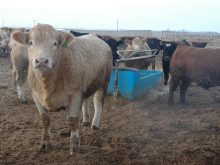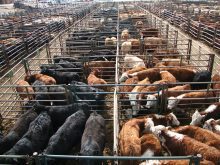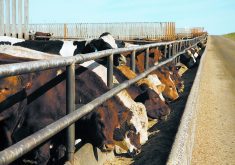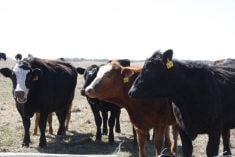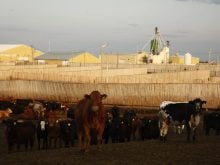Fed Market strong
The fed market tone strengthened this week, and a few more cash cattle were on offer.
However, sale volumes were limited as packers guarded margins with disciplined bids.
Weekly sale volumes were too small to establish a market trend, but the tone was stronger and mirrored Ontario fed trade, where prices were steady to $4 per hundredweight higher.
A handful of steers traded to the United States at US$265 per cwt. rail grade, which should settle out at the feedlot in the mid C$190s on a live basis.
Read Also

Flax sector sees omega-3 opportunity
SASKATOON — A global shortage of omega-3 oils could be an opportunity for the flax sector, says an industry official….
Light volume trade was reported free on board the feedlot at around a $325 delivered rail grade.
A few cash cattle in Kansas traded at US$161 late last week, which was steady with the previous week. Feedlots in other parts of the U.S. Plains held out for at least $163 per cwt.
Canadian feedlots are current in their marketing, and most cattle could actually use more days on feed.
Feedlots were content to carry over cattle to the following week when packers showed little interest in the offerings.
The weekly cash-to-futures basis weakened a little to about -$1.
Weekly western Canadian fed slaughter to March 7 fell two percent to 32,054 head. Slaughter is running at the same pace as last year at this time.
Weekly fed cattle exports to Feb. 28 rose five percent to 4,748 head.
Market-ready numbers should increase modestly during the next couple of weeks but feedlots have good leverage, which will allow them to manage marketings.
Struggling cut-out values could reduce American buying interest, but that is offset by the weakening Canadian dollar.
Cow prices set record
D1, D2 cows ranged C$134-$151 to average $144 per cwt., up about $4.
D3 cows ranged $120-$136 to average $128.13.
Rail grade cows were $273-$277.
Alberta D1, D2 cow prices have risen more than nine percent since the beginning of the year, while Ontario prices have gained 16 percent.
Butcher bulls traded at $154.94, up $2.75, which was $57 higher than the same time last year.
Bull exports to date total 10,772 head, down only one percent from last year, while cow exports are down 29 percent at 42,438 head.
Feeders still strong
The western Canadian calf index established new highs March 12, while the western Canadian feeder index closed the week $4.50 stronger but remained $5 shy of highs set in early January.
Calves and light stockers looked steady by the end of last week, while heavier feeders appeared a touch softer.
Discounts are evident on heavier cattle and feeders carrying excessive tag.
Alberta feeders heavier than 900 pounds are trading at a $6 premium over eastern Canadian values.
Ontario buyers are still buying Alberta feeders but appear less aggressive.
Alberta feedlot demand on the Saskatchewan feeder market has been strong with a good portion of the heavier feeders going west.
A few producers have offered cattle for forward delivery over the past couple of weeks. Late last week, 975 lb. steers were passed at $231 per cwt. for September delivery.
Alberta auction volumes were the largest seen this year, totalling slightly less than 38,000 head.
More assembled groups of cattle have been marketed than one-owner cattle over the past couple of weeks.
Weekly feeder exports to Feb. 28 totalled 11,406 head, which was 15 percent lower than the same time last year.
Feeder volumes are anticipated to peak over the next couple of weeks and drift lower moving into April.
Bred cows ranged $2,200-$3,200 per head, while bred heifers were $2,500-$3,500 per head.
US beef falls
The U.S. Choice cutout was US$245.98, down $3.22, and Select fell 79 cents to $248.79.
With spring just around the corner, pent-up demand for grilling cuts is expected to lend support to the market.
Canadian cut-out values for the week ending March 7 were unavailable.
This cattle market information is selected from the weekly report from Canfax, a division of the Canadian Cattlemen’s Association. More market information, analysis and statistics are available by becoming a Canfax subscriber by calling 403-275-5110 or at www.canfax.ca.



